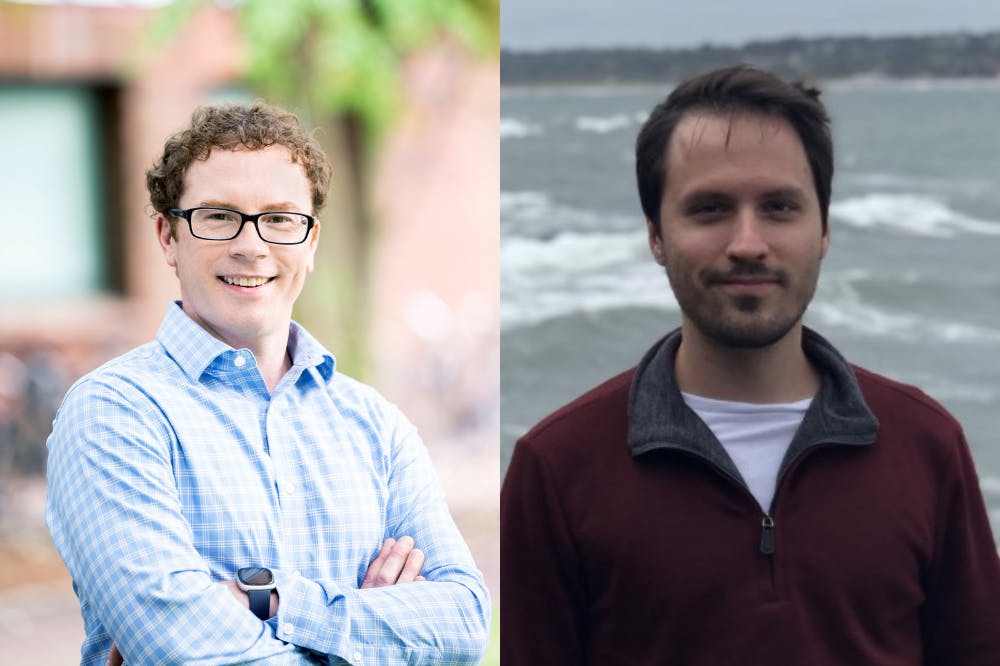From an orbit of over 186,000 miles from Earth, to Utah’s Great Salt Lake Desert, to NASA’s Johnson Space Center in Houston, to College Hill: That’s the path that samples from the asteroid Bennu, weighing less than a paperclip, have taken to arrive to researchers at Brown.
“By getting pristine material like this, we’re just stepping that much closer to being able to answer questions about … how life originated on this planet,” said Ralph Milliken, associate professor of Earth, environmental and planetary sciences. Milliken directs the NASA Reflectance Experiment Laboratory, one of the labs studying samples from Bennu.
RELAB received their first Bennu samples in November of last year and published their preliminary analyses in a June article. Another laboratory, headed by Yongsong Huang — professor of Earth, environmental and planetary sciences — anticipates receiving a specimen in the coming days. They are part of a global initiative composed of over 200 scientists at 38 institutions that characterizes the geology, chemistry and mineralogy of the object.
According to Milliken, Bennu is a so-called “carbonaceous asteroid,” enriched in carbon, salts, organic compounds and water and water-bearing minerals — “all of the raw ingredients that we need for life.”
In addition to these hypothesized results, Bennu also held some surprises. “It’s full of these really interesting phosphate grains that have these huge implications for biology,” said Cody Schultz MSc’22 PhD’24, a postdoctoral research associate at RELAB.
RELAB uses a technique called reflectance spectroscopy, which measures the wavelengths of light reflected off the samples. By measuring this light, including invisible infrared wavelengths, researchers can “understand what these materials are made out of and how we can relate that back to the spacecraft observations,” Milliken said.
Beyond the answers to the origins of life and the formation of our solar system, studying Bennu is also important for protecting humanity and the planet as it is representative of some of the asteroids that most threaten Earth, Milliken explained. “The more information we have … the better informed we’ll be to understand how we might be able to, say, deflect one.”
The Department of Earth, Environmental and Planetary Sciences was a shoe-in for the opportunity to conduct this research, Milliken said. “We have this long and rich tradition and history here at Brown and in our department of not only having the lab, but using its unique capabilities to measure very precious samples,” Milliken explained.
The laboratory has previously studied specimens from the Apollo program, the Soviet Luna program and, more recently, the Japanese Hayabusa2 mission, which collected samples from Ryugu, another near-Earth asteroid.
“There’s that kind of romantic aspect to recognizing the privilege and the opportunity of being able to work with such precious and interesting materials,” Schultz said.
Across Thayer from RELAB, the team of organic geochemists under Huang is preparing to analyze their own sample. They plan to employ innovative methods developed in-house to extract the most data from the tiny amount of material. This project will cost millions of dollars when accounting for mission expenditures.
Previous “methodology is not really releasing all the compounds that are actually embedded in those micro-inclusions,” Huang said.

Instead, they plan to use a multi-stage workflow, according to Ewerton Santos, a postdoctoral research associate. First, they plan to crush the sample in a tailor-made airtight apparatus to release the lighter molecules. Then, they will employ a technique called pyrolysis — using heat to release heavier molecules. Finally, they plan to “fish out” specific compounds using a coated fiber in a technique called solid phase microextraction.
The greatest advantage — and greatest challenge — of the extraterrestrial samples is their purity. “It’s a little nerve-wracking at points because some of the materials … have literally never been exposed to air for their entire four and a half billion year existence,” Milliken said.
Meteorites, the traditional samples used in planetary sciences, are too contaminated to answer the question of how life first appeared. “Water just seeps into them immediately,” Schultz said.
Meteorites also lack “geologic context,” because what asteroid they come from is unknown, Schultz added. By studying specimens directly from outer space, “you can connect these samples to actual physical parts of the asteroid, understand what parts of the asteroid they came from and what it says about the processes that operated on those asteroids.”
This is especially useful for an asteroid like Bennu, which formed when “some bits reassembled in space” after breaking off from a much larger asteroid, Schultz said.
“We’re just seeing the remnants of that (impact) and trying to understand what those processes were and how common they might have been on other objects of that scale,” Milliken said.
For Schultz, who is set to begin a new postdoctoral position at The California Institute of Technology early next year, this work is personal. “I started undergrad at the same time the mission launched from Earth, so the fact that we met up together here at Brown is kind of neat.”
“It really has been a privilege and an awesome opportunity to do this,” Schultz said. “I don't think a lot of grad students get the opportunity to work with such a cool diversity of samples and such pristine, precious samples.”





